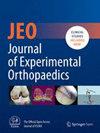Reduced polyethylene wear in dual mobility versus single mobility hip implants: Results from quantitative and qualitative scanning electron microscopy analysis
Abstract
Background
Dual mobility cup in total hip arthroplasties has gained popularity worldwide as it reduces instability providing greater range of motion. However, increased polyethylene wear remains debated. This in vitro study aimed to measure and qualitatively analyse the wear of ultra-high molecular weight polyethylene in contemporary dual mobility cup compared to conventional single mobility acetabular component.
Methods
Hip simulator was used to compare ultra-high molecular weight polyethylene wear in dual mobility and single mobility acetabular component The specimens were tested at an in vitro angle of 30° relative to the ISO standard fixated position. Flexion/extension, abduction/adduction, and internal/external rotation were simulated. Testing was stopped every 0.5 million cycles until 5.0 million cycles were reached and the liners were disassembled and weighted to assess mass loss. The test fluid was sent for scanning electron microscopy analysis and wear particles were characterized for mean equivalent circle diameter, form factor, maximum Feret diameter, minimum Feret diameter, area, perimeter and aspect ratio.
Results
Dual mobility hip reported a lower wear respect to single mobility (20.4 and 39.6 mg/Mcy, p < 0.01). Moreover, conventional acetabular component produced wear particles with higher equivalent circle diameter, area, perimeter, minimum and maximum Feret diameter, while aspect ratio and form factor resulted higher in dual mobility polyethylene wear. No cases of ultra-high molecular weight polyethylene rupture have been reported.
Conclusion
Dual mobility cup produces less wear than conventional single mobility acetabular component ensuring lower risk of instability and greater range of motion. Further studies are needed to definitively clarify the issue of wear in the dual mobility prosthesis.


 求助内容:
求助内容: 应助结果提醒方式:
应助结果提醒方式:


